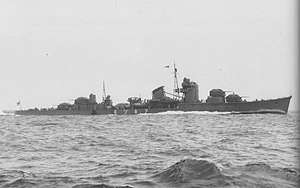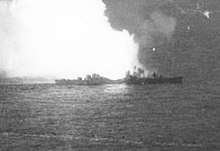Japanese destroyer Akizuki (1941)
 Akizuki on trial run off Miyazu Bay on 17 May 1942. | |
| History | |
|---|---|
| Name: | Akizuki |
| Builder: | Maizuru Naval Arsenal |
| Laid down: | 30 July 1940 |
| Launched: | 2 July 1941 |
| Completed: | 11 June 1942 |
| Commissioned: | 11 June 1942, Yokosuka Chinjufu |
| Struck: | 10 December 1944 |
| Fate: | Sunk in action 25 October 1944 |
| General characteristics | |
| Class and type: | Akizuki-class destroyer |
| Displacement: |
|
| Length: | 134.2 m (440 ft 3 in) |
| Beam: | 11.6 m (38 ft 1 in) |
| Draft: | 4.15 m (13 ft 7 in) |
| Propulsion: |
|
| Speed: | 33 knots (38 mph; 61 km/h) |
| Range: | 8,300 nmi (15,400 km) at 18 kn (21 mph; 33 km/h) |
| Complement: | 263 |
| Armament: |
|
Akizuki (秋月) was the lead ship of her class of destroyer in the Imperial Japanese Navy. Her name means “Autumn Moon.”
Design and description
The Akizuki-class ships were originally designed as anti-aircraft escorts for carrier battle groups, but were modified with torpedo tubes and depth charges to meet the need for more general-purpose destroyers. Her crew numbered 300 officers and enlisted men. The ships measured 134.2 meters (440 ft 3 in) overall, with a beam of 11.6 meters (38 ft 1 in) and a draft of 4.15 meters (13 ft 7 in).[1] They displaced 2,744 metric tons (2,701 long tons) at standard load and 3,759 metric tons (3,700 long tons) at deep load.[2]
The ship had two Kampon geared steam turbines, each driving one propeller shaft, using steam provided by three Kampon water-tube boilers. The turbines were rated at a total of 52,000 indicated horsepower (39,000 kW) for a designed speed of 33 knots (61 km/h; 38 mph). The ship carried up to 1,097 long tons (1,115 t) of fuel oil which gave them a range of 8,300 nautical miles (15,400 km; 9,600 mi) at a speed of 18 knots (33 km/h; 21 mph).[3]
The main armament of the Akizuki class consisted of eight Type 98 100-millimeter (3.9 in) dual purpose guns in four twin-gun turrets, two superfiring pairs fore and aft of the superstructure. They carried four Type 96 25-millimeter (1.0 in) anti-aircraft guns in two twin-gun mounts. The ships were also armed with four 610-millimeter (24.0 in) torpedo tubes in a single quadruple traversing mount; one reload was carried for each tube. Their anti-submarine weapons comprised six depth charge throwers for which 72 depth charges were carried.[4]
Construction and career
Akizuki was completed on 11 June 1942. She participated in the Battle of the Eastern Solomons on 24 August, 1942 and sustained no damage. She participated in the Guadalcanal Campaign as well, helping to guard transports before sustaining a bomb hit and several near misses on October 25 that kill 11 and injure 22 crew and slow her to 23 knots. She returned to Japan and was repaired from 8 November to 16 December 1942. On 19 January, 1943, she was torpedoed by USS Nautilus, which flooded a boiler room and her starboard engine room. She was able to steam at 20 knots and lost 14 dead and 64 injured and had to resort to emergency steering. She returned to Truk and had to spend from February 2 to 11 March alongside repairship Akashi. As she was preparing to return to Japan, however, her bow started sagging and, fearing it was about to break off, she had to be beached at Saipan. She was cut in half and the bridge and forward turrets were removed to lighten ship and replaced with a temporary "wave-cutter" bow. A temporary bridge is constructed behind the mainmast. She was repaired from July to October, receiving the bow from her incomplete sister ship, Shimotsuki. She participated in the Battle of the Philippine Sea, helping rescue survivors from Taiho and help protect Zuikaku from air attack.[5]

In October 1944 Akizuki was part of the Northern Force commanded by Vice Admiral Jisaburo Ozawa, in the Japanese attack on the Allied forces supporting the invasion of Leyte. On 25 October, in the Battle off Cape Engaño, the ship was sunk, probably by torpedo, east-northeast of Cape Engaño (20°29′N 126°30′E / 20.483°N 126.500°ECoordinates: 20°29′N 126°30′E / 20.483°N 126.500°E), during the initial U.S. air attack on the Northern Force. Most sources credit the hit to aircraft of Task Force 38, but some give credit to the submarine USS Halibut.
Notes
References
- Chesneau, Roger, ed. (1980). Conway's All the World's Fighting Ships 1922–1946. Greenwich, UK: Conway Maritime Press. ISBN 0-85177-146-7.
- Jentschura, Hansgeorg; Jung, Dieter & Mickel, Peter (1977). Warships of the Imperial Japanese Navy, 1869–1945. Annapolis, Maryland: United States Naval Institute. ISBN 0-87021-893-X.
- Nevitt, Allyn D. (1998). "IJN Akizuki: Tabular Record of Movement" (Web page). CombinedFleet.com. Retrieved 2 January 2009.
- Watts, Anthony J. (1971). The Imperial Japanese Navy. Doubleday. ISBN 0-385-01268-3.
- Whitley, M. J. (1988). Destroyers of World War 2. Annapolis, Maryland: Naval Institute Press. ISBN 0-87021-326-1.